And Now for More Baking Therapy!🍪
Stressful times call for chunky, chocolatey cookies made the easy way!
I’m like a moth drawn to a flame when it comes to news—especially the terrifying kind. At this moment that’s not a good thing. But I’m trying to step away, take a deep breath and break out the mixing bowls instead. There’s nothing like baking something classic and delicious and sharing it with others who might be feeling about as blue as you are to improve your mood and take your mind off scary and troubling events you feel powerless to change. And, in a time of strife and division, what possible disagreements can you have with anyone when it comes to chocolate chip cookies?
Okay, okay, perhaps a lot. You might prefer chunks to chips, cakey to crisp, semisweet to bittersweet, and on and on. Perhaps you’re gluten-free or vegan or don’t like chocolate at all. (Now there’s something that calls for therapy!) I must admit I hadn’t given much thought to the options until I happened upon the latest cookbook from Los Angeles-based chef and writer Nicole Rucker, Fat + Flour: The Art of a Simple Bake. Having enjoyed and written about (see link below) Rucker’s first book, Dappled: Baking Recipes for Fruit Lovers, I couldn’t resist buying this one.
Named for her popular bakery café, Fat + Flour, with its two Southern California locations, which she owns with her husband Blaine, the book’s cover immediately grabs your attention with those stacks of chip- and chunk-infused cookies. As it happens, they touch all the bases in terms of gooey, cakey, crisp, soft, vegan, gluten-free, chocolate-less, etc.—so you can take your pick.
Cookies, of course, are only chapter one. There are also brownies and bars, bundt and loaf cakes, an entire chapter devoted to banana breads (classic, browned butter, hi-protein, chocolate marbled and spicy streusel-topped), and all manner of pies—fruit, pudding, custard, hand pies and galettes. This last is not surprising, as pies are what first put Rucker on the map in 2012 when she won a blue ribbon at the National Pie Championships and four more locally at the KCRW Good Food Pie Contest.
No to creaming, yes to CBM
Getting back to cookies, what caught my attention when I first came upon Rucker’s cookbook at our local independent bookshop (a shout out to {pages}, still going strong in in our little town after 15 years!), was making cookies using a dough-mixing technique commonly used for pie crusts, biscuits and scones. The Cold Butter Method, or CBM, as Rucker calls it, consists of cutting butter into flour and other dry ingredients instead of creaming room temperature butter and sugar together, the classic first step in almost every cookie and cake recipe that most of us have ever used.
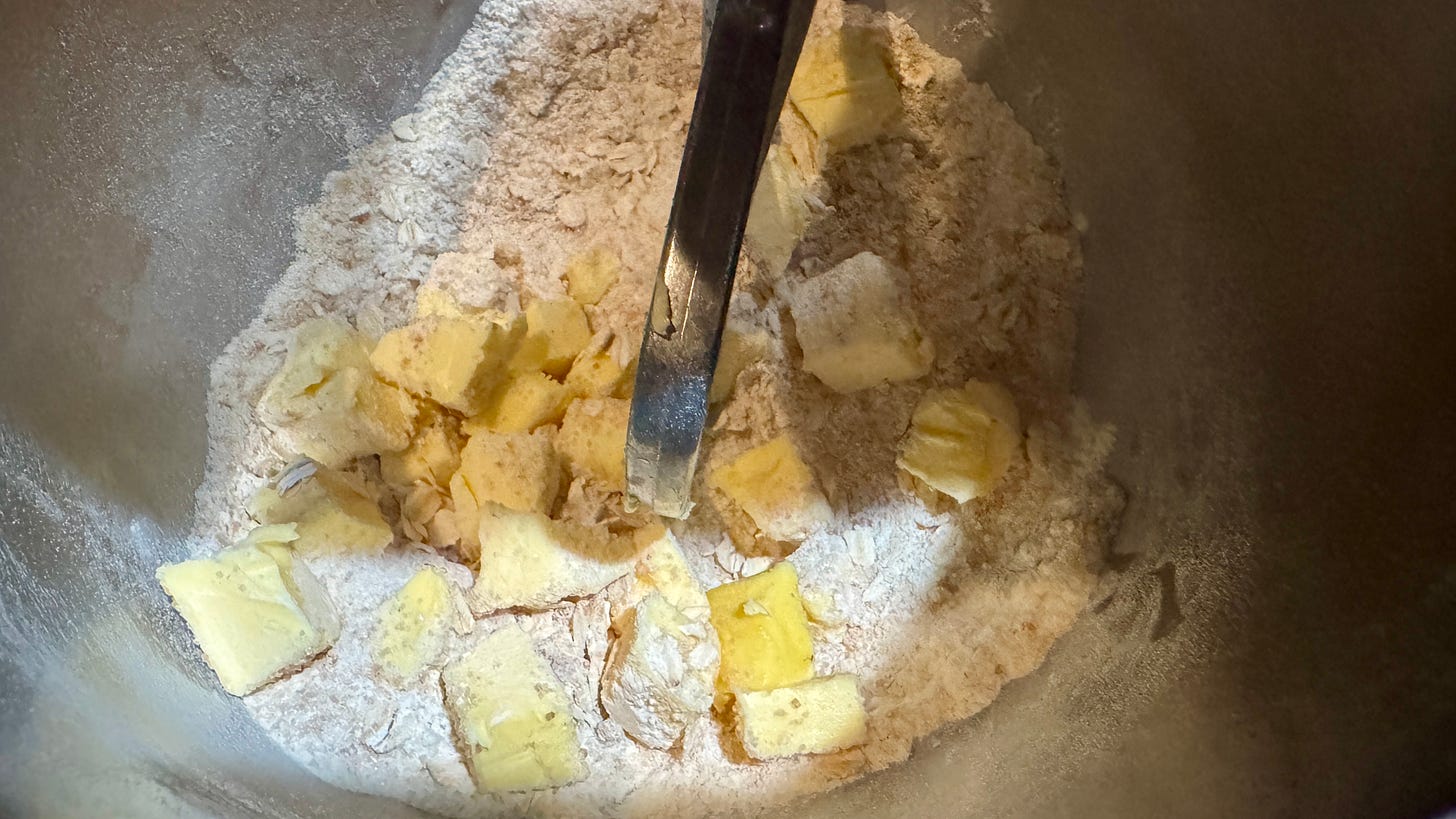
In an interview in late April with Evan Kleiman, longtime host of KCRW Radio’s long-running (and fabulous!) Good Food program/podcast, Rucker described her inspiration for turning to CBM:
“While I was on my forced sabbatical for that first couple weeks of the pandemic, I watched a video by a bakery in the UK called Crumbs & Doilies, where they were reverse engineering a Levain cookie, those big scone-like cookies. One of the things they do is they dump everything in the mixer and they mix it. They don't cream the butter. It was like a light bulb. I was like, "Wait a second, we can do that?" …My head was spinning, and I was thinking, why is every single cookie recipe for the last 80, 90 years starting with cream, butter and sugar, and beat butter and sugar with a spoon? Who made that up and why did we do that? I broke it apart from there. It was like taking apart a puzzle and putting it back together in a new way.”
To hear the entire interview or read the transcript, click here.
I’ve been creaming butter and sugar together as long as I’ve been baking. Going back even further, I recall my mother demonstrating the magic of beating cubes of softened yellow butter and granulated sugar into pale mounds of what looked like a cross between whipped cream and frosting. It was the first step in creating her beloved pound cake. I wrote about that in an earlier piece about the therapeutic benefits of baking:
For many people, waiting for the butter to soften to room temperature is one step too many, especially if they are craving cookies right now! But the technique is also imprecise and fraught with issues because, depending on the time of year, your room temperature may be very different than mine. For example, in my house at this moment, the room temperature is in the mid-70s. If you’re living in the Midwest or East Coast where a heatwave is predicted (or has already arrived!), your butter may turn into a puddle at room temperature.
But still I was pretty dubious about using the Cold Butter Method to make cookies, never mind a cake. The purpose of creaming butter and sugar, according to a 2015 King Arthur Baking post, “is to aerate the butter and fill it with bubbles that can capture the gasses released by your leavener (usually baking soda and/or baking powder).” The more bubbles that are incorporated, the lighter your cakes and muffins will be and the finer and more tender the crumb. As for cookies, the creaming step produces cookies that are “light and crisp instead of hard and dense.”
While I know this is true in most cases, I was eager to give the reverse creaming method a try. Anyway, I had bought the book—and the photos were making me drool!
I started with the very first recipe for 1990s Oatmeal Chocolate Chunk Cookies.
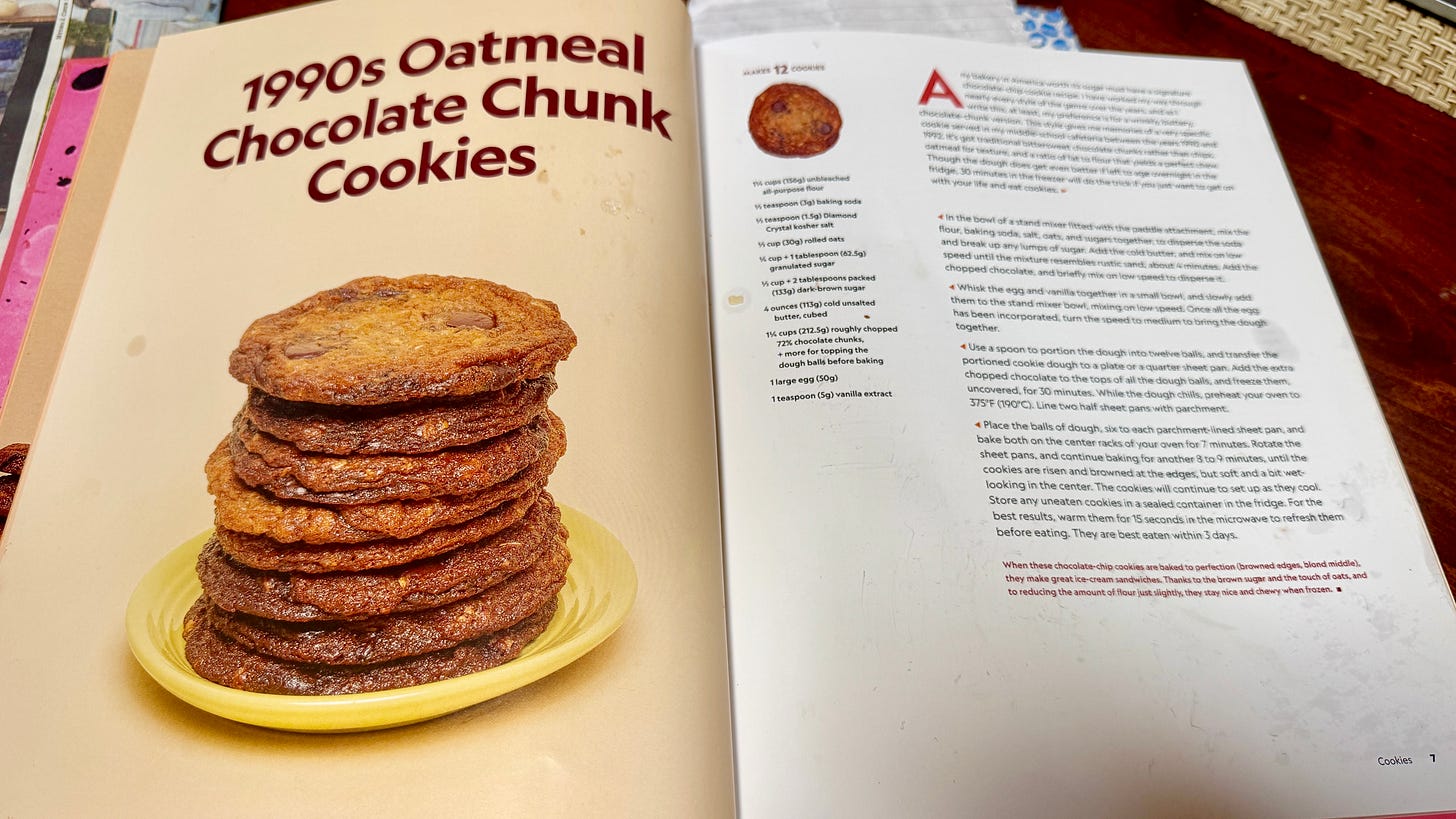
“Any bakery in America worth its sugar must have a signature chocolate-chip cookie recipe,” Rucker says in the headnotes. This one evoked memories of a specific cookie served at her middle school cafeteria in the early 1990s. (My brain immediately goes to some rather awful cookies I’ve tasted in cafeterias, but never mind!). But for this pastry chef, the dream cookie is a “wrinkly, buttery, chocolate-chunk version” using chopped 72% chocolate, rolled oats for texture and a short rest in the freezer to quickly “age” the dough. My mouth was already primed for a cookie before I’d poured a single grain of flour into the mixing bowl.
You can find the recipe at the bottom of this post, with a few notes from me. The cookies—there were 15 large ones from the batch I made though the recipe says it makes 12—were crisp and sturdy and oh so chocolatey! After sampling one, my friend Susie, always to be depended upon for an honest review, texted: “Delicious cookie, so chewy with big pieces of chocolate. Has me singing for satisfaction. Clearly your best in a while!!!!”
Can’t argue with that!
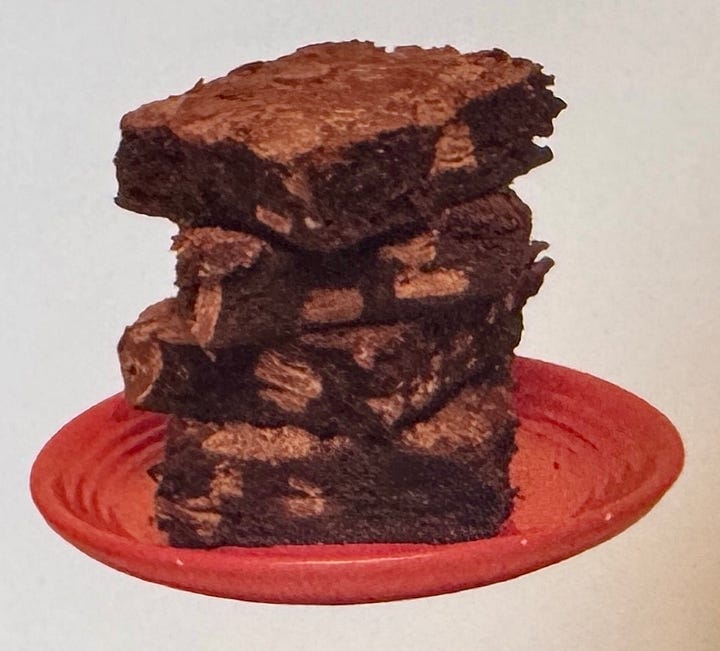
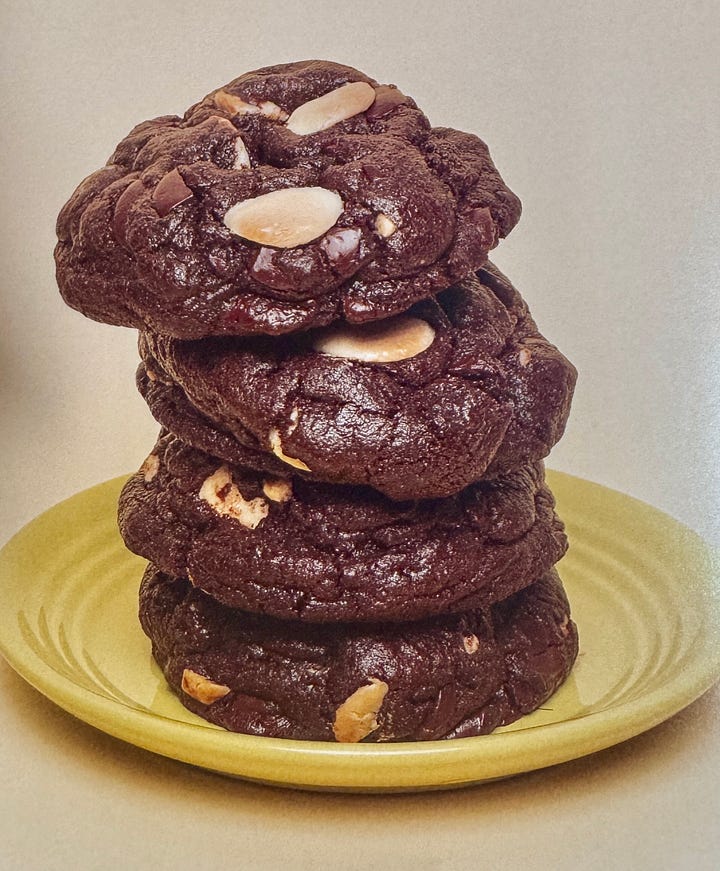
In addition to these, there are other variations whose names will give you some idea of the endless possibilities: East Coast Crunch Cookies, Classic Soft Chocolate Chip Cookies, Vegan Bourbon Chocolate Pecan Cookies, Espresso White Chocolate Cookies, Triple Chocolate Cookies, and Co-Op Tofu Brownie Cookies. (Are you salivating yet?) Then there are the non-chocolate cookies, including three types of Snickerdoodles (Boozy Banana Snickerdoodle Cookies are the ones calling my name!). And of course there are brownies. Among them are Abuelita Milk Chocolate Brownies that illustrate Rucker’s penchant for experimental flavors by including masala chai and hot sauce! You can find the recipe she shared with KCRW’s Kleiman here
This is a fun read, and I’ve already bookmarked many more recipes I want to make (including some of those chocolate chip cookie variations and those banana Snickerdoodles. For carrot cake lovers, the Carrot and Olive Oil Loaf Cake is a keeper. I had to make that too—and it’s already gone, as are the cookies. Oh well, it just means there’s more baking therapy in my future!
How about you? Are baking or cooking sources of comfort and escape—or do you just lose yourself in a book or a series? Have you ever tried the Cold Butter Method to make cookies or cakes? I’d love to hear from you.
Recently I fell in love with Étoile on Amazon Prime Video and binged the first season. Sadly the second has been canceled. It’s worth watching if only for the astonishing ballet sequences, but also for the story and the stellar acting and linguistic abilities of the leads in both English and French. I hope somehow a second season will be magically restored. Here’s a taste:
Recipe: 1990s Oatmeal Chocolate Chunk Cookies
(From Fat + Flour: The Art of a Simple Bake, by Nicole Rucker)
Makes 12 large cookies (or more if you make them a bit smaller!)
Ingredients:
1 1/4 cups (156g) unbleached all-purpose flour
1/2 teaspoon (3g) baking soda
1/2 teaspoon (1.5g) Diamond Crystal kosher salt
1/3 cup (30g) rolled oats
1/4 cup + 1 tablespoon (62.5g) granulated sugar
1/2 cup + 2 tablespoons (133g) packed dark-brown sugar
4 ounces (113g) cold unsalted butter, cubed
1 1/4 cups (212.5) roughly chopped 72% chocolate chunks,* plus more for topping the dough balls before baking
1 large egg (50g)
1 teaspoon (5g) vanilla extract
*Note: I used Trader Joe’s Pound Plus 72% Cacao Dark Chocolate.
Directions:
In the bowl of a stand mixer fitted with the paddle attachment, mix the flour, baking soda, salt, oats, and sugars together to disperse the soda and break up any lumps of sugar. Add the cold butter, and mix on low speed until the mixture resembles rustic sand, about 4 minutes. Add the chopped chocolate, and briefly mix on low speed to disperse it.
Whisk the egg and vanilla together in a small bowl, and slowly add them to the stand mixer bowl, mixing on low speed. Once all the egg has been incorporated, turn the speed to medium to bring the dough together.
Use a spoon to portion the dough into 12 balls,** and transfer the portioned cookie dough to a plate or a quarter sheet pan. Add the extra chopped chocolate to the tops of the dough balls, and freeze them, uncovered, for 30 minutes.*** While the dough chills, preheat your oven to 375°F (190°C). Line two half sheet pans with parchment.
Place the balls of dough, six to each parchment-lined sheet pan, and bake both on the center racks of your oven for 7 minutes. Rotate the sheet pans, and continue baking for another 8 to 9 minutes, until the cookies are risen and browned at the edges, but soft and a bit wet-looking in the center. The cookies will continue to set up as they cool. Store any uneaten cookies in a sealed container in the fridge. For the best results, warm them for 15 seconds in the microwave to refresh them before eating. They are best eaten within 3 days.****
More notes:
**If you make the portions slightly smaller, you obviously get more cookies, though the large size is part of their appeal!
***You can also refrigerate the dough for several hours or overnight, as I did.
****I froze several of the cookies and then microwaved them. They were great! According to Rucker, the frozen cookies also make great ice cream sandwiches. Could there be a better summer treat?
That’s it for this week. Thanks for reading, liking, sharing and commenting. Also, a big welcome to new subscribers! I’m grateful that you’re here.
Stay cool, everyone! See you next time.
Ruth

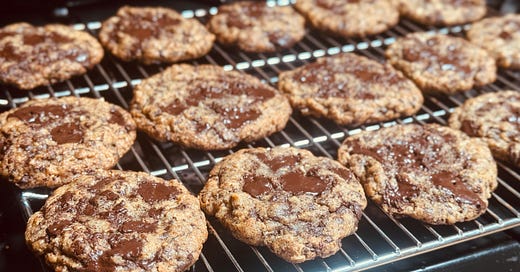


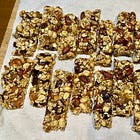
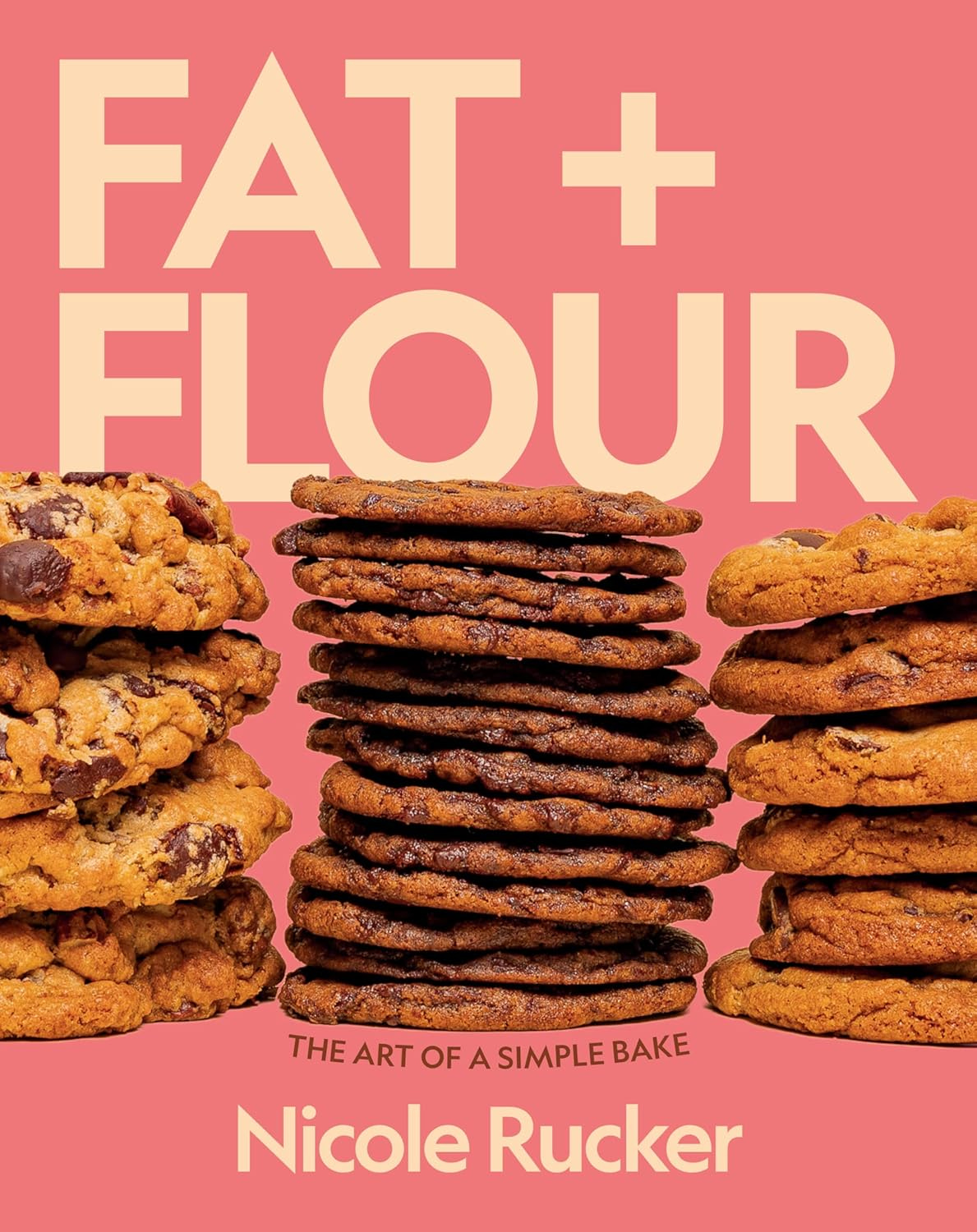

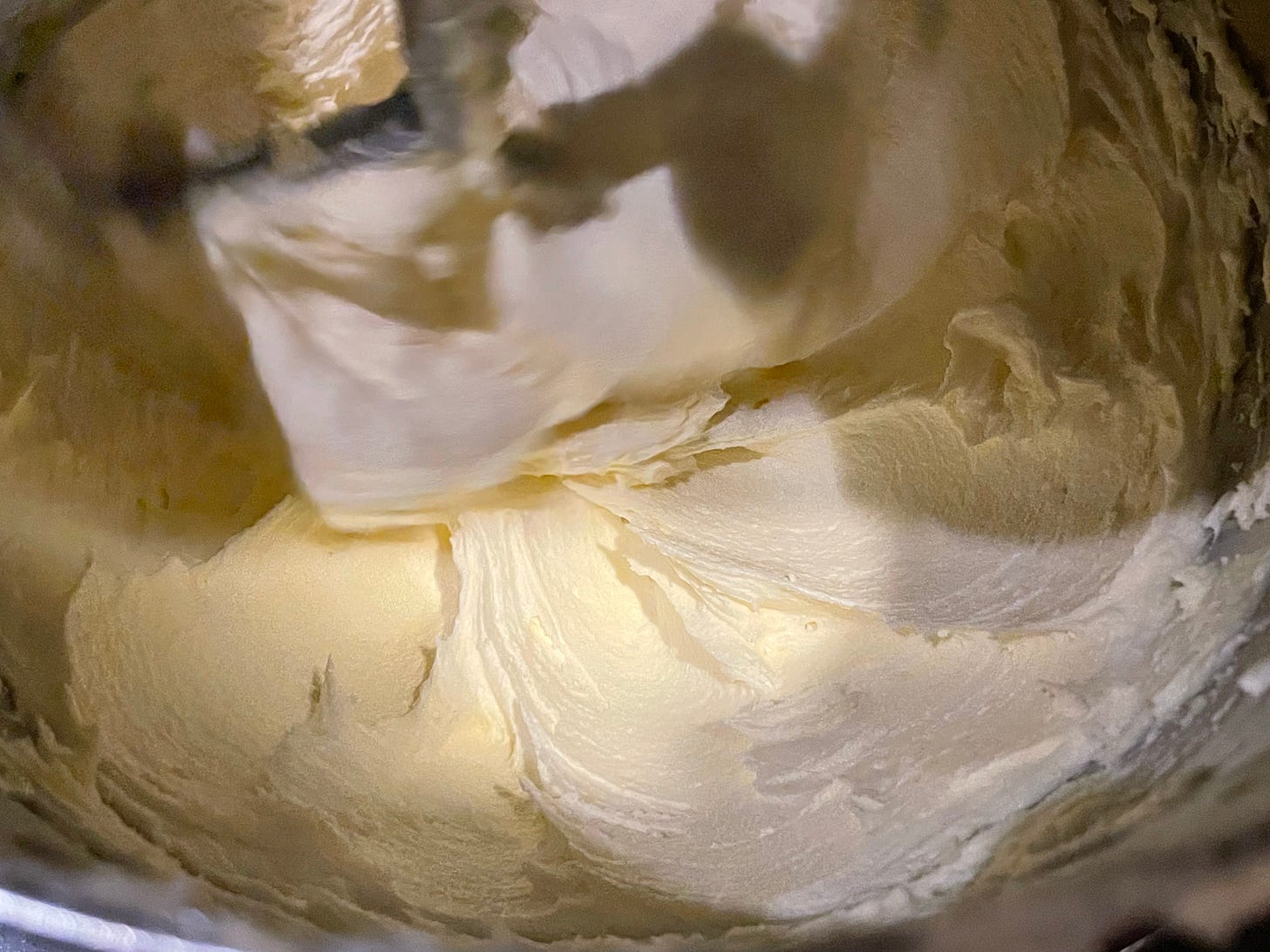
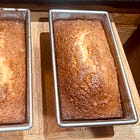
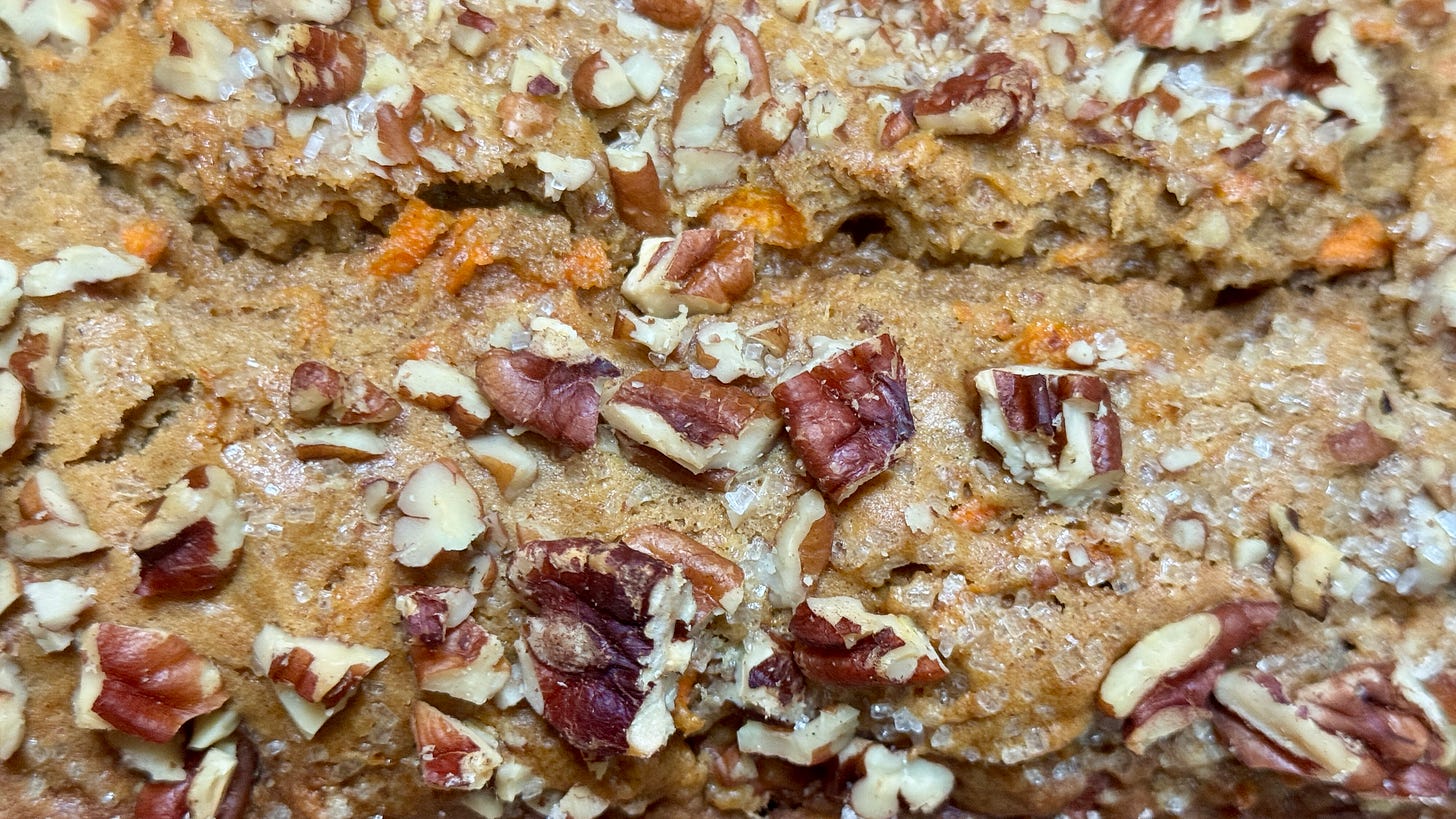
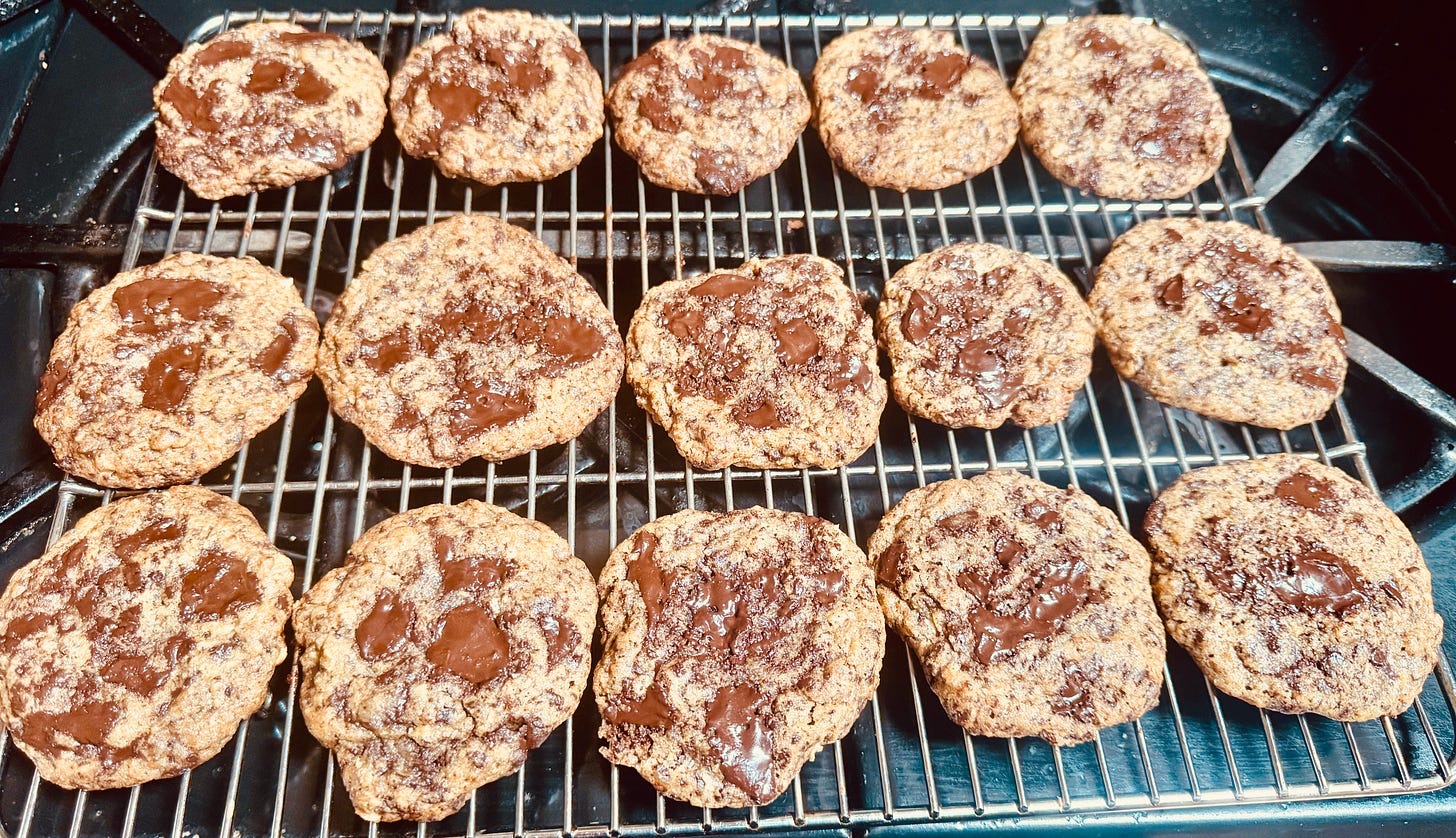
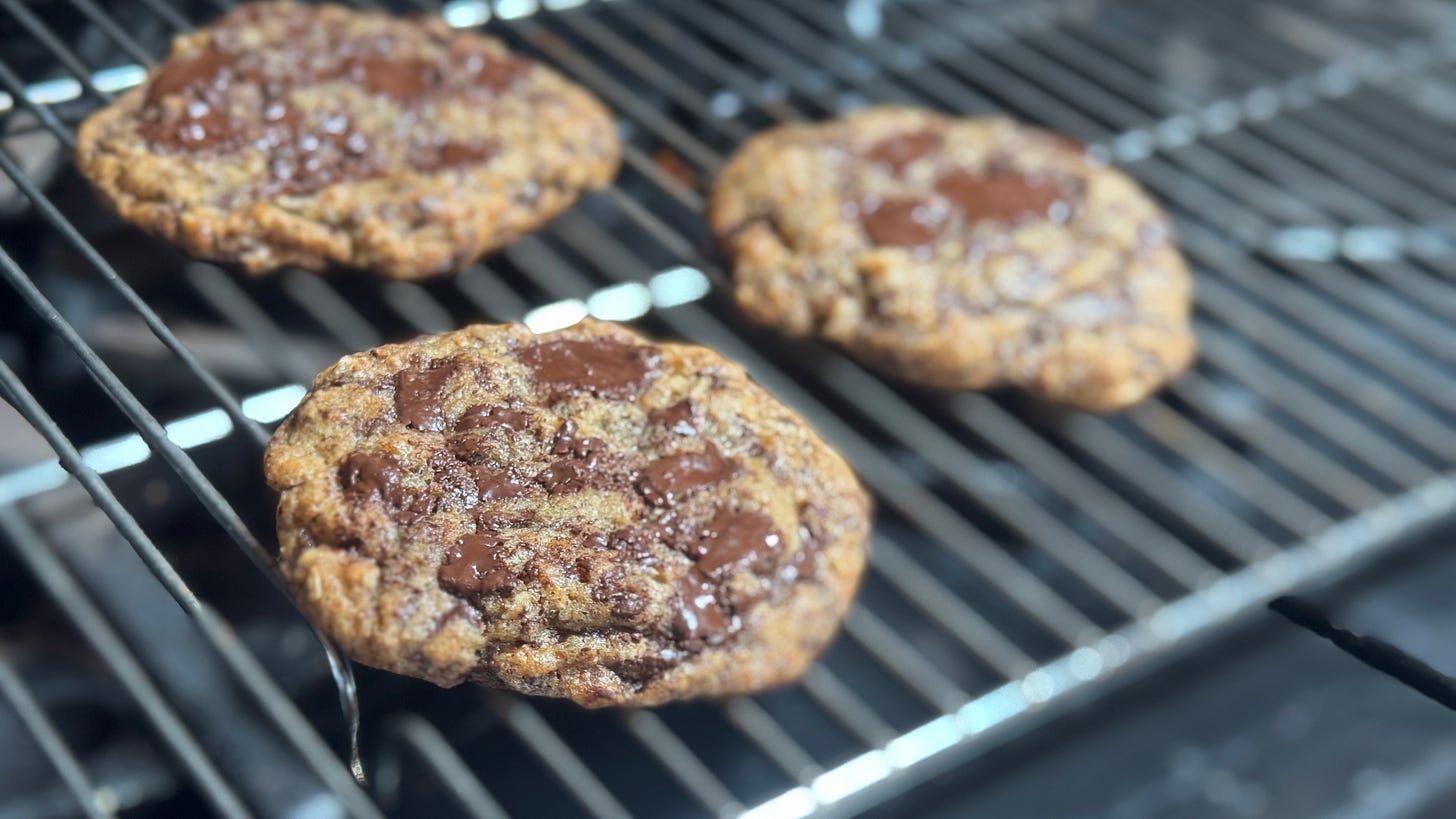
I'm intrigued by the Cold Butter Method. Thanks for sharing. I've always taken my butter out of the fridge to soften on the counter. The cookie choices sound delicious. I am trying to stay calm about the news while getting lost in an Amy Tan novel.
.. anyone ? .. I am looking for delish SUGARLESS cookie recipes .. anyone ? Thank you for the consideration